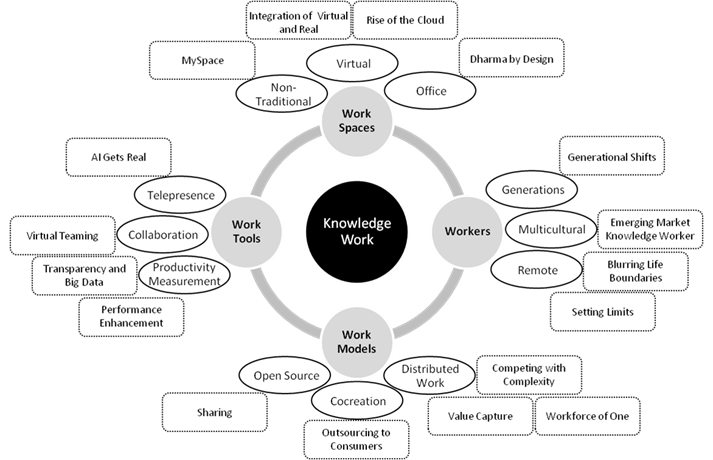T he graphic has the drivers in the rectangles. This is from a project on the future of knowledge work we did about ten years ago. It was interesting that we were able to identify drivers flowing out of each of the domain map categories. It’s a good discipline to try this, but in depending on the topic, there may be multiple drivers from one branch and few or none in some others. A great set of drivers on the web is Arup’s Drivers of Change.
he graphic has the drivers in the rectangles. This is from a project on the future of knowledge work we did about ten years ago. It was interesting that we were able to identify drivers flowing out of each of the domain map categories. It’s a good discipline to try this, but in depending on the topic, there may be multiple drivers from one branch and few or none in some others. A great set of drivers on the web is Arup’s Drivers of Change.
Definition: Help me pick one, please! (1 is simplest, 3 is most accurate for our process)
- A driver is a thematic cluster of related trends that is influencing or shaping change.
- A driver is a thematic cluster of related trends and inputs that is influencing or shaping change.
- A driver is a thematic cluster of related trends, issues, plans and projections that is influencing or shaping change.
Imagine each of the inputs on a separate card on a giant table. (Indeed, in my previous work when we were more often face-to-face, we did this fairly regularly.) Then your task is to cluster the related inputs. There seem to be two principal strategies:
- Pick a primary input that you think is influential, and then look for related inputs
- Simply gather together related inputs.
I often advise the former for those new to the process. If a team is doing this, we share our initial cluster themes, and then modify and combine. We might do a second round of clustering, or move right to prioritization of the initial themes if we are in a hurry. Of course, we’ve been researching the project and likely have some thematic ideas in our heads already. It can be useful to have an “outsider” come in and cluster, as they may see things differently than those immersed in the project.
As one looks across the various scenario techniques, the logics or plots of the stories, are typically built upon a relatively small number of key elements, say a dozen plus or minus six. Of course, more elements are considered, but building the core of the story relies on a smaller number, and the others are mixed or salted in after the core logics/plots are set.
So I think it is useful for us in the program to incorporate this driver step in our core Framework Foresight process. Being familiar and comfortable with driver building will aid students in developing the full range of scenario techniques. — Andy Hines
“1. A driver is a thematic cluster of related trends that is influencing or shaping change.” can be misleading. this definition tells that the nature or origin of Drivers is only from Trends and we cant not select an event, hit, plan, projection …. as driver of change.
Good observation. Indeed, we have updated our definition to: A driver is a thematic cluster of related inputs from scanning and research i.e., scan hits, trends, issues, that is driving or shaping change in a domain. .
hi,
where can I find more about scanning matrix?
Not sure what you mean??
I just read the blog post and the comments. What we tend to do at the European Tourism Futures Institute is not to cluster the ideas at the table thematically, but to cluster them according to cause-effect relations with a team of involved stakeholders. Each step in the clustering process is guided by discussion in which arguments are exchanged. Next, the clusters are revisited for internal consistency, whether they are sufficiently different from each other, and whether there is consensus about the result. Finally, the group tries to identify the force that drives the change in each cluster. Thus, the stakeholder group is trying to build a model of how they think the factors are interrelated and so how the state of affairs is gradually changing over time. This process refers to Causal Layered Analysis.